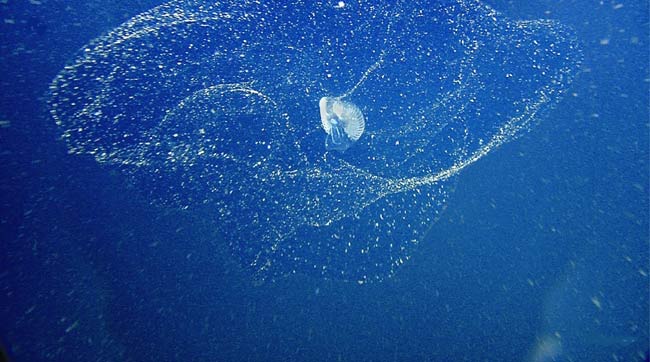Giant Balls of 'Snot' Explain Ocean Mystery

Scientists have discovered giant sinking mucus "houses" that double the amount of food on the sea floor.
The mucus houses, or "sinkers," are produced by tadpole-like animals not much bigger than your index finger. As sinkers drop to the sea floor, small sea critters and other food particles get stuck to the mucus and end up on the bottom of the ocean.
For years scientists have observed loads of life at the bottom of the ocean. But they weren't able to find enough food - carbon - to support all that life. Sinkers, previously overlooked, may help fill that gap.
"We have 10 years of data on sinkers, and using average figures from those years, we can account for twice as much carbon than sediment traps can measure below 1,000 meters," Rob Sherlock of the Monterey Bay Aquarium Research Institute told LiveScience.
The animals responsible for making sinkers are called giant larvaceans. They spin a mucus web, about a yard in diameter. They sit in the middle of the house and use it to filter food that is small enough for them to eat.
"Larger particles get stuck to the outside of these filters, and after some amount of time the filters get plugged and the animal moves out," Sherlock said. "The house deflates and begins to sink, picking up more particles. It's a fast-sinking carbon bomb."
Sherlock usually sees twice as many sinkers as active houses, and sometimes four to five times that amount. So how did they evade scientists for so long?
Get the world’s most fascinating discoveries delivered straight to your inbox.
"A sinker is basically snot," Sherlock said. "It's very fragile. We have very skilled ROV (Remotely Operated Vehicle) pilots and special containers to collect these things. We were only able to adequately collect one out of four."
They're so fragile that sometimes just touching one causes it to rapidly break apart. Sinkers are particularly good at staying out of sediment traps - the most common way of testing the amount of carbon food on the sea floor.
"Sometimes the sinker wouldn't pass through the trap's filter, or would be broken up by it. Or people checking the traps would find this weird goop in the trap, and consider it to be contamination and throw it out," Sherlock said. "Plus, the odds of a sinker landing straight down into trap are fairly slim."
Sherlock and his colleagues have tried to observe larvaceans building the houses in a laboratory tank, but so far it has been difficult because the houses are so fragile.
"We just don't have a tank that's been designed well enough to observe the process," Sherlock said. "We do know that they build very rapidly for a short while, and they probably go through about one house a day."
These findings are published in June 9 issue of Science.
Related Stories
- Mystery of Large Squid Caught on Video
- 'Eel City' Forms at New Undersea Volcano
- Wild Things: The Most Extreme Creatures


